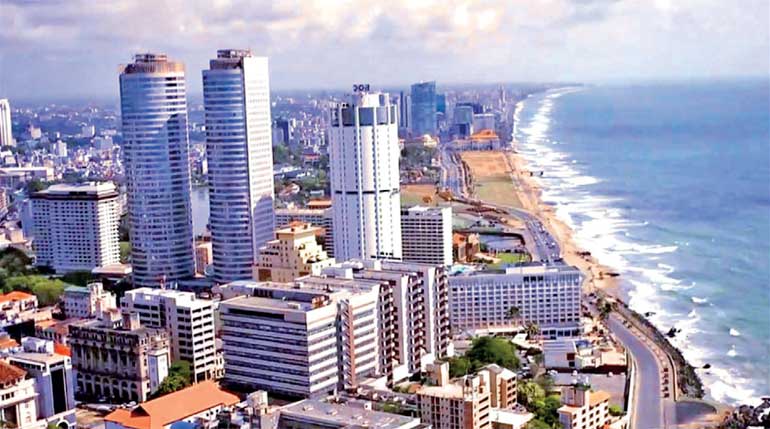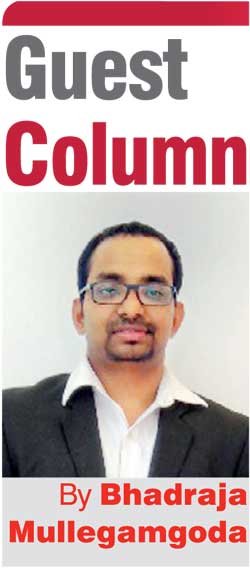Monday Apr 28, 2025
Monday Apr 28, 2025
Friday, 17 February 2023 00:31 - - {{hitsCtrl.values.hits}}

Urbanisation in the country has played a major role in moving from traditional or primitive communities to modern societies
Snapshot of the crisis
The present crisis is complex and structural since it has its own interrelations with three key pillars, social, political, and economic. So, the IMF is just a minor portion of the total response for this crisis. Other parts should be implemented by the President and this unpopular government which is highly unlikely under today’s situation.
On the macro front, according to the IMF, Sri Lanka’s tax-to-GDP ratio is among the lowest in the world. Some of the key factors in the Sri Lankan tax system are low rates, small base, and complexity. This has reduced the general government tax revenue over the recent period. Said revenue must increase, but through a sensitive tax reformation. Consumer price inflation has been on the upward move since September 2021. First as the consequence of monetary side policy responses, later came real side and external shocks. Now Sri Lanka is among the countries with highest inflation rates.
According to the World Food Programme (WFP), one third of the population in Sri Lanka is now facing severe food insecurity. Many more reduce the composition in a meal or sacrifice their meals. Specifically, the estate sector and women headed households have been severely affected by this crisis. As indicated by the Sri Lanka Red Cross Society (SLRCS) and the International Federation of Red Cross and Red Crescent Societies (IFRC), the impacts are multi-dimensional including health, crime, education, individual debt obligations, and businesses. These are signalling a forthcoming severe socio economic crisis.
Problem with Sri Lankans
 Sri Lankans are living at a time which required an intellectual clarification for the social and political situation of the country. According to Max Weber’s readings, the British have given us a governance system which Weber called it as “rational-legal authority”. This is where the ruling party is bound by legal rationality and legitimacy. All developed nations, typically the West, had followed this path. Consequently, this is a proven governance model for a country. But with other factors, as defined by Weber, “traditional authority” and “charismatic authority” have integrated into our social and political systems over many decades of time. During the last presidential election, Gotabaya Rajapaksa’s media campaign portrayed the types of charismatic qualities within the boundaries of autocracy and dictatorship. Part of the society, perhaps the majority also have requested this type of governing body, without knowing the consequences.
Sri Lankans are living at a time which required an intellectual clarification for the social and political situation of the country. According to Max Weber’s readings, the British have given us a governance system which Weber called it as “rational-legal authority”. This is where the ruling party is bound by legal rationality and legitimacy. All developed nations, typically the West, had followed this path. Consequently, this is a proven governance model for a country. But with other factors, as defined by Weber, “traditional authority” and “charismatic authority” have integrated into our social and political systems over many decades of time. During the last presidential election, Gotabaya Rajapaksa’s media campaign portrayed the types of charismatic qualities within the boundaries of autocracy and dictatorship. Part of the society, perhaps the majority also have requested this type of governing body, without knowing the consequences.
Take another simple example. At the top of the decision-making levels, mostly, officials are personal dependents or favourites of either president or ministers. This is true even at the bottom layer of the society. E.g., take the decision-making members in a farmer organisation. All personnel are dependents or favourites of the FOs president, and the FOs president has a closer relation with the local-government politicians. This is a characteristic of traditional authority. This type of behaviour is closely associated with favouritism, cronyism, and worst of all corruption.
The mixture of these systems finds it difficult to establish a ruling principle or ideology for the country. This eventually took down the entire social and political systems. Without any ruling principle or ideology e.g., American dream in early 20th century, civilisation and enlightenment in Japan during early years of the Meiji period, how could one wish to improve the values of the society? The ideology must be built up at leadership level. Then the trickle-down effect would change the values of a society.
Take two simple examples for ideology, 1) Sri Lanka is famous for subsidy-oriented culture. This is one of key highlighted facts in every political campaign. In this context, political popularity is solely depending upon the provision of subsidies in terms of employment, money income and other necessities. 2) When looking at the MSME composition of the country, dragging micro enterprises into the either small or medium level status is the key to boost the private sector. But the major constraint is lack of entrepreneur culture. So, who should bear the blame? The clear-cut answer is weak leadership of the country. Because reforms must be made and implemented at the policy level within a steering frame, then in the long run, these effects would change the behaviour of individuals.
The next decade-long political crisis is now visible on the grounds. This is a ship without a captain and a steering. No captain means no leadership, no steering means no direction. President Ranil Wickremesinghe has his own private propaganda and certainly not the country first. The SLFP is said to be the right-wing coalition, but now they do not know what that even means. SJB also flagged for a movement under traditional local political culture, but the country required a new vision and direction. The NPP is gaining some momentum in the country but more homework is yet to be done.
Urbanisation as a potential solution
Urbanisation is complex and wide. In today’s dynamic world, urbanisation is a process of multi-layer interrelations within social, political, economic, and ecological elements within certain jurisdiction. Once people have urbanised, they tend to interact with these elements. As a result, they would experience different environments of employment, income, productivity, leisure, and cultural diversity. These would enable them to form higher expectations and reach self-fulfilment needs. Following represent some of the key benefits from urbanisation in Sri Lanka over the post-liberalised era.
Employment and education opportunities – Industries and services have spread wide across large and small urban centres in the country, specifically in the Western Province. These non-agricultural activities have created immense opportunities over the years. Also, public sector and education establishments have attracted inhabitants from other parts of the country.
Urban wealth level – According to the Department of Census and Statistics, urban money income level is higher than the rural. But possibly many rural Sri Lankans may have stronger wealth levels than urban dwellers. Although lack of diversity and security have made it idle. More diversified urban wealth has created a service-based culture in the cities.
Flow of technology – In early centuries, during the arrivals of Portuguese, Dutch, and British, new technologies were seen in the port cities of Galle, Colombo, Jaffna, and Trinco. In the 21st century cities have become an integral part of the global economy. As a result, technology has become more available to the people and it has created more technology-based communities, from ICT based employment to Uber rides.
Modernisation – Urbanisation in the country has played a major role in moving from traditional or primitive communities to modern societies. Millennials and Gen-Z have become the strong force behind this transformation. For example, people tend to discuss gender equality and LGBTQ+ representation more broadly nowadays.
Social mobility driven by urbanisation – This has increased a greater portion of the middle class in the country. Expansion of supermarket chains, lease markets, private education, healthcare, and other recreational services are signalling the changes of lifestyles of the emerging middle class.
Importance of the benefits from urbanisation
First, it always starts with social uprisings. In history, almost all uprisings have started in the urban areas. In 509 BC, Lucius Junius Brutus gathered people of Rome to rise up against the last of Tarquin Kings, cities have played a major role in American revolt, and urban uprisings have supported to end the communist regimes in Czechoslovakia, Poland, East Germany, Bulgaria, and Romania. Latest is the Arab Spring.
These similarities have been seen in the face of Aragalaya, where people in Colombo and suburbs have gathered against the corrupted Rajapaksa regime. Impact of urbanisation was one of the driving factors for a regime change. The higher the rate of urbanisation is dangerous for regimes promoting despotism, corruption, and captivity. Adolescents in the middle class have formed their expectations for a decent and free lifestyle. Further, increased flow of information with IoT (Internet of Things) has slightly increased the awareness of social and political factors. Other urban interactions including service based culture, global interactions, social and ethnic diversity, professional segmentation (bus driver to bank manager) and others have influenced the growing realisation of the need to create sustainable political and economic structures.
Also, an added advantage of this crisis is, now people tend to be more aware of some political and economic factors. For instance, they tend to be more aware on the importance of a corruption-free economy. These benefits would eventually create more sensible urban communities, and possibly spill over to the rural counterparts of the country.
(The writer is a researcher and PhD student at the University of Colombo. He is also serving as an Assistant Secretary to Sri Lanka Economic Association (SLEA). He has presented his own views and could be reached via email at [email protected].)
Discover Kapruka, the leading online shopping platform in Sri Lanka, where you can conveniently send Gifts and Flowers to your loved ones for any event including Valentine ’s Day. Explore a wide range of popular Shopping Categories on Kapruka, including Toys, Groceries, Electronics, Birthday Cakes, Fruits, Chocolates, Flower Bouquets, Clothing, Watches, Lingerie, Gift Sets and Jewellery. Also if you’re interested in selling with Kapruka, Partner Central by Kapruka is the best solution to start with. Moreover, through Kapruka Global Shop, you can also enjoy the convenience of purchasing products from renowned platforms like Amazon and eBay and have them delivered to Sri Lanka.
Discover Kapruka, the leading online shopping platform in Sri Lanka, where you can conveniently send Gifts and Flowers to your loved ones for any event including Valentine ’s Day. Explore a wide range of popular Shopping Categories on Kapruka, including Toys, Groceries, Electronics, Birthday Cakes, Fruits, Chocolates, Flower Bouquets, Clothing, Watches, Lingerie, Gift Sets and Jewellery. Also if you’re interested in selling with Kapruka, Partner Central by Kapruka is the best solution to start with. Moreover, through Kapruka Global Shop, you can also enjoy the convenience of purchasing products from renowned platforms like Amazon and eBay and have them delivered to Sri Lanka.